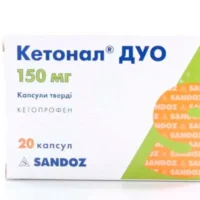Description
Aponil (Nimesulide) Tablets 100 mg. №20
Ingredients
Active ingredient: Nimesulide 100 mg per tablet.
Dosage
Recommended dosage: The usual dose is 100 mg twice daily.
Indications
Aponil tablets are indicated for the treatment of acute pain, painful osteoarthritis, and primary dysmenorrhea.
Contraindications
Do not use Aponil tablets if you have a history of allergic reactions to nimesulide or other NSAIDs, active peptic ulcer, severe heart failure, or severe liver or kidney impairment.
Directions
Take Aponil tablets with a full glass of water. Do not crush or chew the tablets. It is recommended to take the medication with food to reduce the risk of stomach upset.
Pharmacological Properties
Nimesulide is a nonsteroidal anti-inflammatory drug (NSAID) with analgesic and antipyretic properties. It works by inhibiting the production of prostaglandins, which are mediators of inflammation, pain, and fever.
Side Effects
Common side effects of Aponil tablets may include gastrointestinal discomfort, headache, dizziness, and skin rash. In rare cases, severe allergic reactions or gastrointestinal bleeding may occur.
Benefits Compared to Analogues
Aponil tablets offer the advantage of effective pain relief with a lower risk of gastrointestinal side effects compared to some traditional NSAIDs.
Suitable Patient Groups
Aponil tablets are suitable for adult patients including the elderly but should be used with caution in individuals with a history of gastrointestinal ulcers or cardiovascular disease. The safety and efficacy of Aponil tablets in children have not been established.
Usage Instructions
For optimal results, follow the prescribed dosage and duration of treatment. Do not exceed the recommended dose to avoid potential adverse effects.
Storage and Shelf Life
Store Aponil tablets in a cool, dry place away from direct sunlight. Check the expiration date on the packaging and do not use the tablets after the stated shelf life.
Packaging Description
Aponil tablets are available in packs of 20 tablets. Each tablet is film-coated for easy swallowing and protection from moisture.





